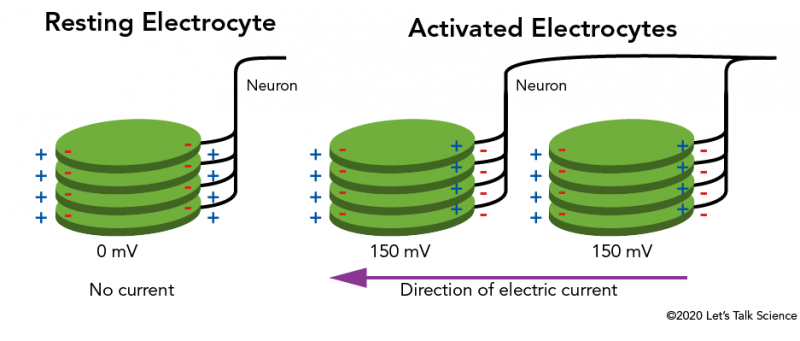Generating Electricity: Electric Animals

Neon sign of a fish in a bowl (Anna_leni, iStockphoto)

Neon sign of a fish in a bowl (Anna_leni, iStockphoto)
How does this align with my curriculum?
Learn about animals that generate their own electricity!
You may have heard of a few ways of generating electricity. Things like wind turbines and batteries. But did you know that some living things can also generate electricity?
Can you think of any animals that could do this? If you thought of electric eels, you’d be right!

Did you know?
An electric eel isn’t a type of eel. It’s actually a type of knifefish.
Electric eels are probably the best known electrogenic animals. Electrogenic animals can generate their own electricity. There are also animals that can detect electricity. They’re called electroreceptive.
Most electrogenic animals are also electroreceptive. But there are many electroreceptive animals that are not electrogenic. Some electroreceptive animals are echidnas, platypuses, bees, spiders, dolphins, sharks and rays. Some types of bacteria, yeast and fish are also electrogenic.
Electric Fish
Almost 350 species of fish can generate and detect electrical signals. Why so many fish? It can be very dark underwater. Fish can use electricity to communicate and move around in the dark. They can also use it to attack prey.
Scientists classify electric fish into two groups. Weakly electric and strongly electric.
Weakly Electric Fish
Weakly electric fish have electric organs in their tails. This structure can generate up to one volt of electricity. An AA battery generates 1.5 volts of electricity. The electric field produced by electric organs travels about 1 metre around the fish.
Weakly electric fish also have special cells in their skin. Electroreceptor cells help the fish sense changes in its own electric field. The fish can sense the size, shape and location of objects through changes in its electric field. It can also sense if there are other, similar fish nearby. This ability is called electrolocation.
Weakly electric fish don’t make enough electricity to attack prey.
The elephantnose fish is an example of a weakly electric fish.

Strongly Electric Fish
Only a few types of fish are strongly electric. These include electric eels, electric catfishes and electric rays.
Did you know?
Strongly electric fish were once used in medical treatments. Electric stimulation was used to treat pain, headaches and gout.
The elephantnose fish only has one electric organ. But electric eels have three pairs of electric organs! Together these organs make up four-fifths of the eel’s body.

Eels generate low-voltage pulses for electrolocation. But they generate high-voltage pulses for hunting and self-defence. These pulses can be up to 860 volts. Electric eels are the most powerful electric fish. Shocks from them can be deadly to humans.
How do these fish generate electricity?
The fish’s electric organ is filled with disc-shaped cells. These are called electrocytes. Electrocytes are positively charged on the outside. They are negatively charged on the inside.
But sometimes the fish sends a message from its brain. This signal travels through its nervous system to its electric organ. There, it changes the pattern of electrical charges in the cells. One side of each stack becomes positive. The other side becomes negative.

This alternating pattern of charges creates an electrical current. This turns the electrocytes into a living battery! The signals reach the cells at exactly the same time. This turns stacks of electrocytes into a series of batteries. This increases their total voltage.
So why don’t these fish zap themselves?
Scientists aren’t really sure why. It may be that the current leaves their bodies too quickly to hurt them. It may be that fish’s electric organs are far away from its other organs. Scientists also think electric fish may have proteins around their electric organs. These could act as insulators.
Learn More
How do fish make electricity? (2017)
This TED-Ed video (5:14 min.) by Eleanor Nelsen explains how electric fish were discovered by scientists, and how they generate their electricity.
Electric eel batteries (2017)
This video (3:42 min.) from Nature explains how researchers have been inspired by electric fish to build new and better batteries for wearable tech.
How Do Sharks and Rays Use Electricity to Find Hidden Prey?
This video (3:50 min.) by Deep Look shows how some underwater animals use their extra sense - electroreception.
References
Bouchard, A. (2015 November 17). Here's How Electric Eels Produce Their Electrical Shock. Labroots.
Bullock, T. H.; Hopkins, C. D.; Ropper, A. N.; Fay, R. R. (2005). From Electrogenesis to Electroreception: An Overview. Springer. doi:10.1007/0-387-28275-0_2.
Caputi, A. (2005 December 5). How do electric eels generate a voltage and why do they not get shocked in the process?. Scientific American.
Hewitt, J. (2014 July 1). Eel muscle could be the first step towards human-generated electricity. Extreme Tech.
Kawasaki, M. (n. d.). What is an electric fish?. University of Virginia.
Nelson, M.E. (2004 November 9). Electric Fish. Current Biology, 21(14), R528-9.
Samim, A. (2017 March 3). ELECTROGENESIS IN FISHES. Slideshare.net.